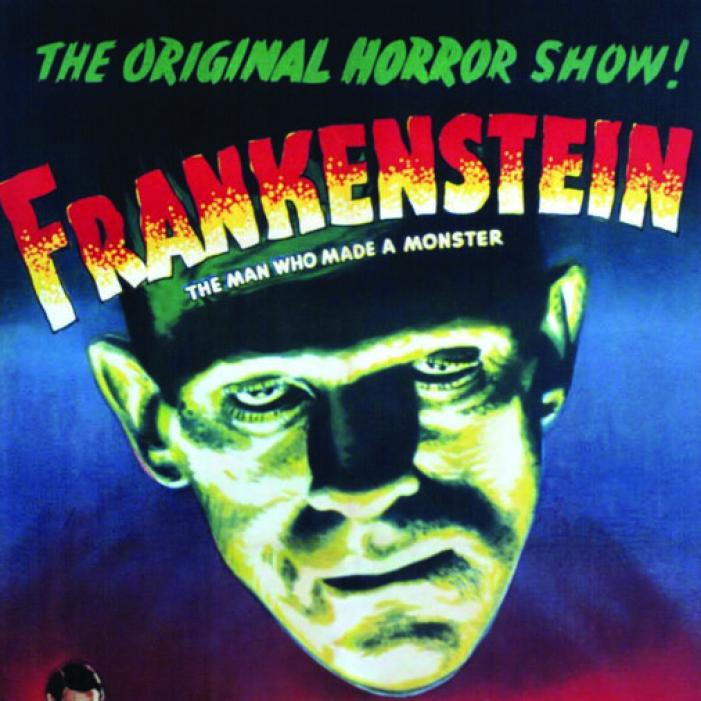Stay In Lock Down: Invite The Living Dead
So for fully 14 minutes we can return to the flickering visuals of Edison Studios’ 1910 Frankenstein, clearly based on a stage version of Mary Shelley’s novel, and see Charles Ogle’s lumbering monster emerge from a vat of chemicals – but not to worry, it’s all just the fevered dream of an overwrought scholar. Not so in the 1931 Universal classic that gave posh British character actor William Henry Pratt (sensibly re-named Boris Karloff for professional purposes) the chance to define forever the looming presence of the electrode-garnished Creature, a nightmare vision yet also an abandoned child. Listen to the refined disgust in the rejection intoned by Colin Clive’s Frankenstein - “Take it away!” - and you’ve hit the real horror. The thing ain’t right, arrogance took us a step too far and the burden of responsibility will never ever go away. Universal Studios tacked on a happy ending, but that just gave the Creature an open return ticket, valid forever. If it proved impossible to recapture the impact of Karloff’s performance, Hammer Films did provide an icily intellectual Dr/Baron Frankenstein with Peter Cushing’s interpretation in their 1950-70s series of variations. For a jollier riff, try 1975 musical The Rocky Horror Picture Show where Tim Curry demonstrates, like Clive and Cushing, that it’s all in the voice (and Meat Loaf rides a motorbike).
You can start silent with Dracula too, but since Expressionistic German director F.W. Murnau didn’t clear copyright with the estate of Bram Stoker, in his 1922 Nosferatu the vampire becomes Count Orlok. Different kind of horror here – not misguided research creating a monster but an ancient infection spread by bodily fluids that casts deep shadows across our brief, sunny hopes, mutating health into sickness, death and worse to come. Despite one or two later homages, however, actor Max Schrek’s bald, spidery goblin of a vampire never became a familiar prototype. That came when Hungarian actor Bela Lugosi donned a cape and intoned “children of the night – what music they make!” Compared to the brilliant visual eccentricity of Nosferatu, Tod Browning’s 1931 Dracula looks stilted and stagey, but it’s all in the sexy accent, social status and hypnotic gaze of the alpha male threatening your honour as much as your neck. However much you yearn to open your bedroom window, first consider where he’s been: the smelly undead corpse of legend has been cleaned up into a brilliantined lounge-lizard, but still carries the contagion of the grave. Innumerable sequels, send-ups and re-imaginings tended to hype up the blood (colour helps) but the seductive cautionary theme of the attractive stranger who is death is also hard-wired into the story (and us). The recent Gatiss/Moffat BBC drama toys wickedly with both the ideas and omissions of Stoker’s original novel.
And completing our trilogy of Things That Should Not Be (but you’re going to spend an evening with them anyway) is the zombie, hailing from the folk-lore of Haiti rather than literary tradition. A Voodou priest, by magic/suggestion/poison, puts their victim into a life-suspending state to create as a mindless slave, poignantly denying even the peace of death to those from a background of real-life slavery. There’s a completely mad take on this in Victor Halperin’s 1932 movie White Zombie and a thoughtful, atmospheric re-thinking in Jacques Tourneur’s 1943 I Walked with a Zombie, but perhaps these are not the zombies you seek? George Romero’s low-budget 1968 film Night of the Living Dead posited a realistic contemporary American setting where the titular monsters (not initially called zombies) were potentially everyone. For reasons unknown the recently dead (still decomposing) start stumbling around trying to eat the brains of the living, an impulse that devastatingly threatens all social and emotional bonds. Though any vampiric glamour of the grave was notably absent, after several sequels the concept was re-vamped with surprising success via series such as The Walking Dead.
Our friendly neighbourhood zombie horde might be the best movie recommendation for any stay-in Post-Apocalyptic evenings, though you can lighten the mood with Simon Pegg’s wonderfully British comedy version Shaun of the Dead. Oh yes – that title echoes Romero’s own 1978 sequel Dawn of the Dead, the one where the zombies lurch round the shopping mall in chaotic post-mortem consumerism, filling their trolleys with loo-roll multi-packs – or was that just my last trip to the supermarket?
Sign Up To Little Crack


